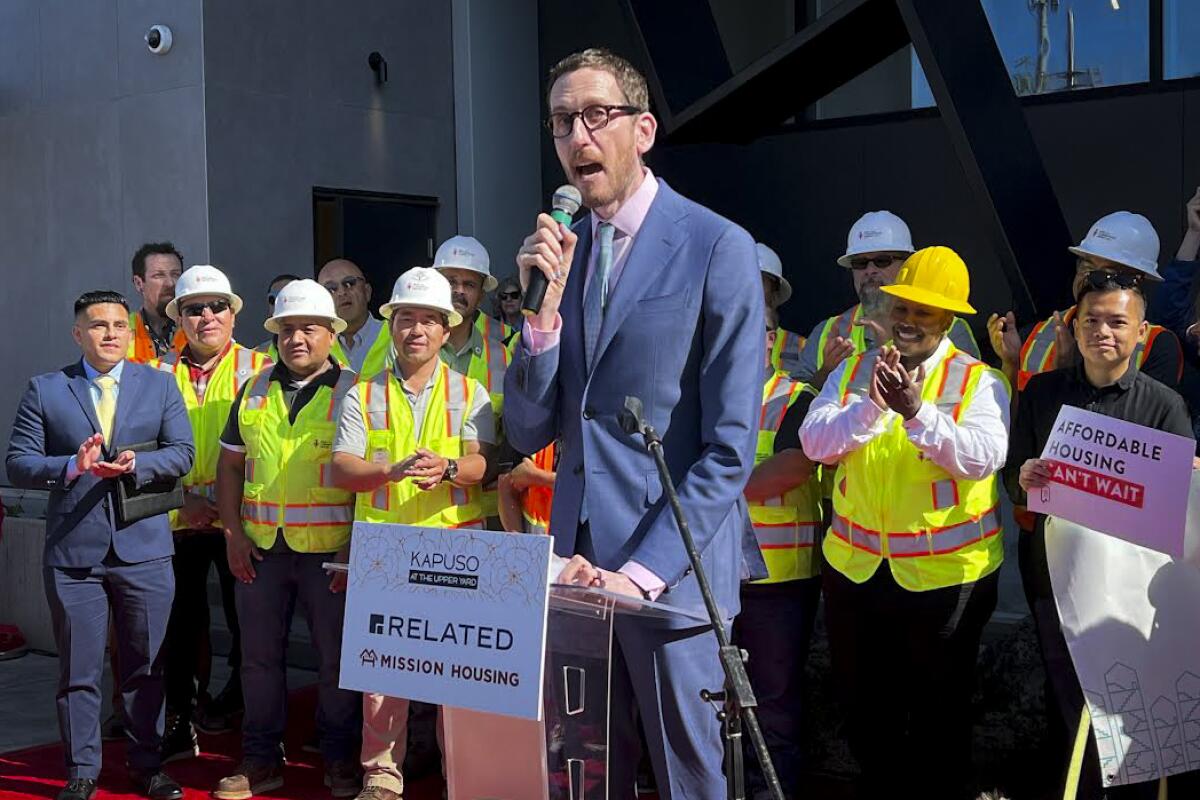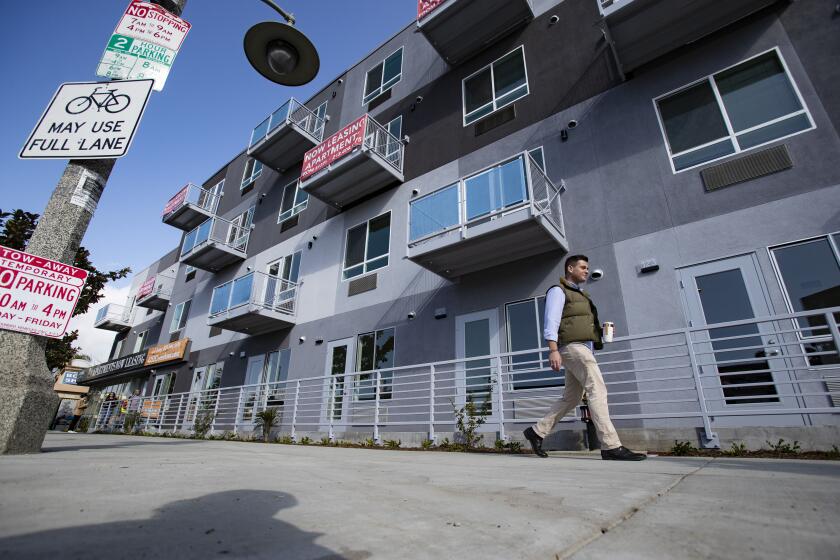California just cut the red tape on housing in San Francisco. Is L.A. next?

- Share via
For decades, San Francisco’s reputation has been that it’s too difficult to build new homes — despite a dearth of housing that’s contributed to a growing homelessness crisis.
But that’s expected to change soon under an expanded state law that promises to cut red tape and speed construction.
Officials estimate the law, Senate Bill 423, will cut approval time for projects in San Francisco from two years to six months, streamlining that housing advocates consider a much-needed course correction in a city where construction is beset by delays and high costs.
Housing advocates hope the new rules in San Francisco means other major California cities in need of more housing, including Los Angeles, will similarly be pushed in the coming years to expedite development as the state more broadly grapples with an estimated 2.5-million-unit shortage.
California lawmakers approved legislation to expand a law allowing developers to quickly build housing in cities falling behind on construction goals.
The state-mandated change will transform the City by the Bay from having one of the longest approval times for new housing to one of the shortest, said state Sen. Scott Wiener, a San Francisco Democrat who wrote SB 423, which Gov. Gavin Newsom signed in October.
Wiener said the new rules will spare developers from the “hyper-political mosh pit” of the housing permitting process in San Francisco, where regulations on where and how homes get built are notoriously stringent.

The law now shields the majority of housing projects from the Board of Supervisors’ scrutiny and allows developers to skip through the long wait times, hearings and environmental review processes that tack months, if not years, on to a project’s timeline — causing some efforts to stall or be blocked completely.
“We have spent decades and decades in San Francisco layering process after bureaucracy after obstacle after bureaucracy after process,” Wiener said during a Monday news conference announcing the changes. “One after the other for the last 50 years, and have methodically made it hard or impossible to build the number of homes that we need.”
Wiener’s law expanded and extended by another decade a 2017 bill that allowed developers to skip through much of the housing approval process that often becomes the logjam for construction in San Francisco.
The original law — initially set to expire in 2026 — led to more than 18,000 proposed units in California, according to an August report from the UC Berkeley Terner Center for Housing Innovation, which said nearly two-thirds of those were considered 100% affordable, meaning all their units were reserved for low-income tenants.
That law applied years ago in San Francisco, but only to projects that designated at least 50% of the units as affordable. Since then, more than 3,600 homes were expedited for approval, according to the San Francisco Planning Department, with about 88% considered “below market rate.”
Still, San Francisco has fallen woefully short of its housing goals by tens of thousands of units. Last year, the city adopted what’s known as a “housing element,” or a blueprint for how it plans to build 82,069 units over an eight-year period. The city has approved only 3,870 new units since 2023, according to the Planning Department.
That sluggish start kicked SB 423’s broader rules into effect, which include more frequent reviews of the city’s compliance with its housing goals.
Builders in San Francisco are now allowed to speed through the approval process for market-rate projects too, as long as they set aside at least 10% of the homes for low-income families and adhere to certain union-approved labor requirements.
“It all starts with housing. And for decades, this city has said no to housing,” said Mayor London Breed, who has pushed for more development in the city as a way to ease homelessness and bring down sky-high rents. “Enough is enough. San Francisco is not a museum that should be stuck in time. ... We have to move this city forward.”
It’s unclear what broader effect SB 423 will have in other California cities.
In Los Angeles, 3,587 units have been approved under the 2017 law, according to the city planning department, but the streamlining rules are limited to projects that include at least 50% of affordable units.
An additional 50,000 units have received the green light for construction under a slew of other city programs to encourage affordable housing near public transit and in multifamily neighborhoods.
Los Angeles’ housing plan will be reviewed again in 2026. If it’s determined that the city has also fallen behind on its market-rate goals, projects that include at least 10% of below market-rate units could become eligible for streamlining, according to the state housing department’s SB 423 rules.
But there’s also only so much one housing law can accomplish.
Though state and city housing officials have passed laws that in theory speed up development, construction costs have surged in recent years with increasing interest rates, on top of expensive labor requirements. Developers also pay additional fees that, in some cases, make the project’s total price tag unfeasible.
There’s also political opposition from the so-called NIMBY movement — short for “not in my backyard” — which is resistant to more construction in traditionally single-family or low-density neighborhoods.
Breed and Wiener hinted at that opposition on Monday, taking swipes at their political rivals in San Francisco city government who’ve opposed multifamily housing projects, namely Board of Supervisors President Aaron Peskin. A progressive Democrat, Peskin has raised concerns that changes to zoning rules will make it too easy to build larger, high-priced projects in certain neighborhoods, typically the wealthier enclaves in the northern and western parts of San Francisco.
Peskin is running against fellow Democrat Breed in what has become a competitive mayor’s race this November that has brought into focus many of the city’s major issues, including housing affordability and homelessness.
In a statement, Peskin said that “real obstacle” to building more homes is financing, and that SB 423 could become a “boon for speculators and developers who will build expensive units out of reach for most San Franciscans.”
“I am not surprised by the Mayor’s enthusiastic support for this as she has consistently backed the agenda of speculators and developers at the expense of what is best and most needed for working and middle-class San Franciscans,” Peskin said.
More to Read
Sign up for Essential California
The most important California stories and recommendations in your inbox every morning.
You may occasionally receive promotional content from the Los Angeles Times.












